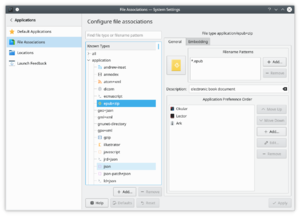Impostazioni di sistema/Associazioni dei file
 |
Modifica un tipo di file esistente, creane uno nuovo |
Lo spazio di lavoro e le singole applicazioni conoscono le varie specie e i vari tipi di file: per questo possono gestirli in maniera appropriata. La finestra delle impostazioni ti permette di configurare come ciascuno di essi viene gestito; ti permette inoltre di definire un nuovo tipo, e di modificare come viene riconosciuto uno già noto.
In alternativa puoi configurare un tipo di file in Dolphin, utilizzando uno dei tre metodi per modificare le associazioni dei file.
Configurazione dei tipi di file conosciuti
Nell'elenco nella parte sinistra della finestra troverai uno strumento di ricerca e un elenco di tutti i tipi di file conosciuti raccolti in vari gruppi. Per trovare un tipo di file, digita nella riga di inserimento in alto una parte del tipo di file o del modello del nome del file.
{{Note|1=Se stai cercando un tipo di file in base all'estensione del nome del file, potresti dover digitare esplicitamente il carattere punto. Ad esempio, per cercare il tipo di file di quelli che finiscono con ".c" (file sorgenti in linguaggio C), digita *.c o semplicemente .c, ma non *c: in questo contesto, l'asterisco ("*") non agisce da carattere jolly.
Puoi anche navigare nell'elenco dei tipi di file: espandi semplicemente la categoria rilevante, poi entra nella lista di tipi di file che compare. Alcune liste, tuttavia, sono molto lunghe.
To modify a file type, locate it in the list of file types and click on its name. Now you will see two tabs in the right side of the dialog.
In the tab you can change the icon associated with this type of file by clicking the icon button in the top left of the tab. You can add or remove file name patterns in the list, thereby defining which files are recognized as having this type. The list in the bottom part of the tab names the applications that will show up in the context menu, when you right click on a file of this type. The first application in the list is the one that is used when you left click on the file.
The options in the tab affect how the file type is handled by Konqueror, when it is used as a file manager.
Adding new file types locally
To add a new file type click on the button below the list of file types in the left side of the window. That brings up a dialog where you should select a group from the dropdown list and enter a name in the text field. Then click the button to create your new file type.
Now you can edit the new file type in exactly the same way that you modified an existing file type.
Requesting new file types
The KDE software guesses filetypes using the shared-mime-info database, which is shared with many other software projects. To request a new file type to be added to the database, please, follow the instructions here.


